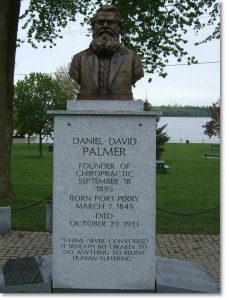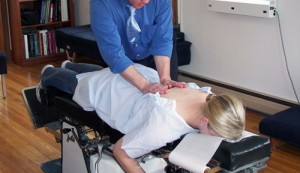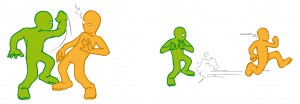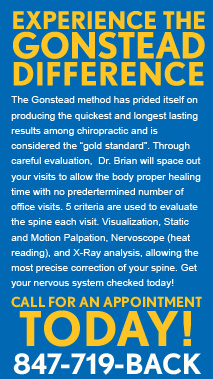Vanderbilt Chiropractic
New Year, New You

A resolution is a firm decision to do or not to do something. Usually a resolution is made not putting enough forethought into how we will accomplish it. Quite often resolutions are thought of as denying yourself of life’s pleasures and we find it very difficult to make it to the end of the first week of the new year without breaking them.
A lifestyle change is a process that takes time and requires support. Once you’re ready to make a change the difficult part is committing and following through. So do your research and make a plan that will prepare you for success. Careful planning means setting small goals and taking things one step at a time. There are several areas we can target to make positive changes that make life more enjoyable and feeling good is a great goal.
Many struggle with making healthy food choices which is the main cause of excess weight. Foods that aren’t great for us are easily accessible. Making a lifestyle change to mainly shop the outside isles of the grocery store and/or cut out white foods (pasta, flour and sugar) are a good start. Our bodies actually crave these types of food the more we eat them. If you replace these white foods with colorful fruits and vegetables you will begin to crave “good for you” foods. As they say we should eat a rainbow of colored fruits and vegetables each day.
We can also reset our systems and stop “junk food” cravings by doing a cleanse. In just a few days you will notice your craving for simple carbohydrates are vanishing. Complex carbohydrates in fruits and vegetables gives you more of what you need and also gives your immunity a boost. If you stick with the cleanse you will shortly notice you’re feeling better overall. You’re sleeping better, have more energy since you’re eliminating toxins better and you have probably have lost a few pounds. Healthy living is a choice. It’s easier than ever to make good choices with Standard Process’s purification kits. The kits come in regular, vanilla and chocolate flavors. There is a dairy free option and all are gluten free and vegetarian. To help you jump start this lifestyle change we recommend the Standard Process 21 Day Purification Cleanse Kit. This is an easy program to follow and can be purchased from us. If you have any questions about this product we would be happy to talk to you about it.
Exercise is where many of us also fall short. Just 30 minutes of exercise that gets your heart beating faster on most days is a good goal to shoot for. If you are struggling with excess weight you could increase the amount of exercise you do which can help you meet your weight goal. Exercising doesn’t have to be running. Some people just don’t like to run, but they can get fit with many other kinds of exercise. Even walking is better than nothing. What ever you do make sure it is fun so you will stick with it. Perhaps the family dog can benefit from your commitment to making a lifestyle change. Grab a leash and take them along.
Stress is also a thief of our well being. Sometimes we aren’t even aware that we are stressed. Take time for you. Find a hobby that doesn’t require a lot of mindfulness. It’s good to not critically think even if only for a short time. A regular habit of doing this helps enrich our lives. Adults are now finding pleasure coloring in adult coloring books. The pages are beautiful and gives you ways to express your creativity just like we did as children. Reading a good book, listening to favorite music or even watching a good movie helps us unwind and disconnect from everyday stress. So let’s make 2017 be the year of “YOU”. It’s OK to take care of ourselves and just maybe those positive life style changes we make will trickle down to those we love and care about. Make it your year!
What is Chiropractic?
Chiropractic is…..

Chiropractors not only do spinal adjustments to restore proper alignment which restores nerve supply to the body, but they are also a wealth of information on many subjects which can help us achieve or stay healthy. Quality vitamin and mineral supplements are good to help fight infections and boost our immunity. 
Our foods are processed to the point where they no longer offer the nutritional value they once did. From the planting of the seed to the harvesting of the plant the growing process has been modified and diminishes the end products value to our bodies. Nutrition is a key factor to our over all good health. Our world is full of different types of whole foods which we have never tried or even heard of. It’s good to challenge ourselves to try new whole foods. Many have healthful properties if prepared keeping your health in mind.
We have an epidemic of diseases that attack our bodies and are directly caused by what we eat. This is alarming because rather than make diet and lifestyle changes that heal our bodies from the inside out we are quick to take pills that don’t cure these conditions but only maintain them. Medication has many unpleasant and sometimes dangerous side effects. If a person diagnosed with high cholesterol stop eating processed foods and followed a whole food diet adding daily fish oil and exercise, they most likely would see this condition greatly improve. This is a much better remedy than taking Statin drugs which are usually prescribed. The risk of very serious side effects are muscle pain, liver damage, kidney failure and even death.
Don’t think of your chiropractor as a physician who only deals with spinal misalignments, think of them as someone who has a wealth of knowledge and information to help you heal your body and is only too happy to share his knowledge with you and your family. We always welcome your questions and are glad to offer information that enhances your life.
The “Back Breaking” Chores of Autumn
 We see more injuries from spring and fall yard clean up than winter snow removal. As your clearing out your gardens, pruning trees, raking leaves and even shoveling the occasional early snow fall. it’s important to follow safe back care during your yard clean up. Here are some tips to help you keep your back feeling great during what could be “back breaking” chores.
We see more injuries from spring and fall yard clean up than winter snow removal. As your clearing out your gardens, pruning trees, raking leaves and even shoveling the occasional early snow fall. it’s important to follow safe back care during your yard clean up. Here are some tips to help you keep your back feeling great during what could be “back breaking” chores.
- See your Chiropractor for a spinal adjustment prior to doing strenuous yard work. A spine in good alignment is your best tool when tackling tough yard work.
- Stretch, arms, legs, neck and back before you head outside. This warms the muscles and prepares them for the work ahead.
Pace yourself and take your time with heavy items or stubborn weeds and plants. It is important to take breaks often when doing long stretches of yard work. - Lift with your arms, legs and back as one unit bending at the knees.
- Rest and regroup when you’re starting to feel tired. Remember, taking a break helps keep you from overworking which is just as important as getting the job done.
- Stay well hydrated. Dehydrated muscles are more prone to injury. Taking that needed break while hydrating is important.
- Maintaining good posture while mowing, raking or shoveling. Good posture can also prevent back problems. Taking a break is a good idea too!
- Take the pressure off your back using the “scissor” stance when raking. Put your right foot forward and left foot back, then reverse after a few minutes. Don’t forget to take breaks, it’s important!
- Start or continue strengthening your core muscules and increase aerobic activity to lessen the chance of straining your low back.
- If you didn’t catch it above, TAKING BREAKS is very important. Taking a 10 minute break once per hour to stretch/recover/hydrate will go a long way in preventing back injuries.
You may still feel stiff and sore the day after doing a lot of yard work, ice to soothe the discomfort. If there is no improvement in your aches and pains within 48 hours, call us for an appointment. Chiropractic treatments are highly effective in treating muscle pain (remember your spine and nerves control your muscles) and will get your back and you feeling good.
10 Things Most People Don’t Know About Chiropractic

National Chiropractic Health Month spotlights the public health crisis caused by pain, and in particular the overuse of prescription painkillers. The media continues to cover the issue of pain extensively, following the Centers for Disease Control and Prevention’s declaration of the overuse and abuse of opiod painkillers in the United States as an “epidemic”, Chiropractic is an effective solution to combat the pain crisis in America.
Spread the Word
10 Things Most People Don’t Know About Chiropractic
1. Pain is the last symptom of dysfunction. A patient’s back is often restricted or unstable for months or years before it presents as a problem and they show up in a chiropractor’s office. In addition, the absence of pain is not health. While medication may be needed, if you take a pill and the pain goes away, the dysfunction that caused it still persists. Muscle, ligament and joint injuries often occur as a result of long-term bio-mechanical dysfunction, sometimes from past injuries, making the area more susceptible to future injury.
2. Athletes use chiropractors to stay well and perform better, not just for the occasional injury. Athletes choose chiropractors because we are movement specialists. Chiropractors were spotted all over the Olympic coverage this year, and top athletes such as Michael Jordan, Tiger Woods, Michael Phelps, Tom Brady, Evander Holyfield, and Arnold Schwarzenegger have all been proud patients of chiropractors. Female athletes also benefit from chiropractic care. Dr. Mike Foudy team chiropractor for the Women’s World Cup Championship Team in 1994 states “all but one member of the team received regular chiropractic care during their training and on the days of their matches. Chiropractic adjustments balanced their spine, removed nerve pressure and optimized the function of their bodies. They felt like they healed quicker from injuries and that the care gave them a competitive edge.” These days it’s far more common than not for major athletes and sports teams to keep chiropractors nearby to help prevent injuries, speed injury recovery, improve balance and coordination, and give them a greater competitive edge.
3. The body does not perform as a cluster of separate mechanisms, but rather a cascade of events that all starts with proper control by the nervous system. The nerves that travel through and control every function of your body originate at the spinal cord and their transmission may be disrupted if the joints of the surrounding spinal column are not moving properly. This disruption in biomechanical integrity combined with altered physiological function is what chiropractors call a subluxation. Below is a chart that illustrates the relationship of the spinal nerves exiting the vertebra branching off to the various organ systems. You can see why it is not uncommon for a chiropractor to treat a patient with mid-back pain who also suffers from irritable bowel system, a patient with a subluxated sacrum who has been unsuccessfully trying to become pregnant, or a patient with an upper back fixation and acid reflux.
4. Doctors don’t do the healing. Sorry to disappoint you, but a chiropractor will never fix your back. What we are able to do is restore proper motion in the joints, which relieves tension on the nerves and muscles and allows your body to do the healing that it is inherently made to do. Chiropractors believe that the body is a perfect organism in its natural state, and all disease comes from a disruption in the body’s proper transmission of signals by the nerves which affects its ability to heal and to defend against disease-causing agents. Chiropractors never treat disease. We assess to find which spinal levels are causing the dysfunction, and we adjust it to restore proper nerve flow so the nervous system may work as efficiently and effectively as possible.
5. Chiropractic is for all ages. Many seniors are not aware of the benefits of chiropractic care which can help them not only with pain relief, but also increase range of motion, balance and coordination, and decrease joint degeneration. There’s no patient too young for chiropractic either! Chiropractors check infants moments after birth for misalignments of the upper vertebrae that may occur as a result of the birth process. In addition to supporting overall health and well-being, parents also take their children to chiropractors to encourage healthy brain and nervous system development, to assist with colic, asthma, allergies, bed-wetting and sleeping problems, and to assist with behavioral disorders.
6. We know about more than your backbone! This surprises many people who had no idea that chiropractors give advice on nutrition, fitness, ergonomics and lifestyle, screen for conditions unrelated to the musculoskeletal system and refer out to other practitioners when necessary. Chiropractors are also able to complete specialties in other areas such as pediatrics, sports rehabilitation, neurology, clinical nutrition, and addictions and compulsive disorders.
Other than particular specialties and the differences in learning to adjust and learning to prescribe medication, our training hours are not dissimilar from that of medical doctor. The following are the classroom hours for basic science requirements compiled and averaged following a review of curricula of 18 chiropractic schools and 22 medical schools.
7. Successful chiropractic patients accept responsibility. When somebody says that they tried chiropractic and it didn’t help, we cringe and get the feeling that they really missed the boat. Of course, there are cases with complicating factors, but we have heard this from people with straightforward chiropractic problems when it is very clear what has happened here. In most cases, one doesn’t acquire back pain over night, and it’s not going to go away over night. If a weak core from years of sitting at your desk is to blame for the additional stress on your joints, we would expect an adjustment to provide relief, but once the condition is no longer exacerbated, we would most definitely prescribe some exercises for you to do at home. The doctor might also suggest he evaluate your nutrition if he suspects an inflammatory diet may be wiring you for pain. Sure, the doctor is always happy to adjust someone, but if you’ve been given homework and you don’t do it, remember that this has to be a team effort!
8. Chiropractic may help you get sick less. Studies have indicated that adjustments consistently reduce the production of pro-inflammatory mediators associated with tissue damage and pain, and may also enhance the production of immunoregulatory complexes important for healthy immune system defense. As far back as the deadly flu pandemic of 1917-1918, chiropractors noticed that their patients seemed to have fewer fatalities than among the general population and were able to publish their work in an osteopathic journal since no scholarly journals were accepting chiropractic data. The estimated death rate among patients of conventional medical care in the U.S. was estimated at 5 to 6 percent while the fatality rate among influenza cases receiving spinal adjustments was estimated at 0.25%.
9. “I heard I’ll have to go forever” is a myth. You may want to go to your chiropractor forever once you’ve started because you didn’t realize how great getting adjusted is, but your doctor won’t expect you to come for continuous care without symptoms. Generally, if you come in with pain, once you’ve been treated for your initial complaint, you’ll be scheduled for a few more appointments to make sure proper motion is being maintained, then it will be recommended you return occasionally to be checked just like you would go to the dentist to get checked for tartar buildup and cavities. Many people choose to see their chiropractor more frequently for wellness or maintenance care.
10. Adjustments don’t hurt. There is no bone snapping or warrior-style pulling heads off spinal columns! The neck adjustment some chiropractors use causes anticipation for many new patients, but is actually much more gentle than they imagined, and involves a quick, direct thrust to a specific spinal bone. The sound an adjustment makes is called a cavitation and is only space being created within the joint causing gasses to be released from the joint capsule, which creates the popping or cracking noise. Also, chiropractic adjustments will not wear out your joints, as some imagine because they have been warned in the past not to “crack their knuckles” for this reason. Adjustments, unlike “knuckle cracking” or having your friend stomp on you while you lay on the carpet, are applied specifically to improve the alignment of your joints and limit the small dysfunctions that over time can lead to arthritis. Most people after an adjustment describe the feeling as being “lighter”, having greater ease in moving the body, and being able to stand up taller.
Resources: omaleydc.wordpress.com
Happy 121st Birthday to Chiropractic! September 18th is Founders Day for Chiropractic
 On September 18, 1895 the first chiropractic adjustment was performed by Dr. DD Palmer, a magnetic healer of the time. The patient was Harvey Lillard. Mr. Lillard, a janitor in the Ryan building on the corner of Brady and 2nd Street in Davenport Iowa, had been nearly totally deaf for 17 years. After the historic first adjustment, Harvey’s hearing returned. This revelation led Dr. Palmer to theorize that nerve interference from a spinal bone out of place was the cause of Harvey’s hearing loss. He further affirmed that returning the bone to a more normal position might help correct the problem. It was from this simple beginning that the chiropractic profession was born.
On September 18, 1895 the first chiropractic adjustment was performed by Dr. DD Palmer, a magnetic healer of the time. The patient was Harvey Lillard. Mr. Lillard, a janitor in the Ryan building on the corner of Brady and 2nd Street in Davenport Iowa, had been nearly totally deaf for 17 years. After the historic first adjustment, Harvey’s hearing returned. This revelation led Dr. Palmer to theorize that nerve interference from a spinal bone out of place was the cause of Harvey’s hearing loss. He further affirmed that returning the bone to a more normal position might help correct the problem. It was from this simple beginning that the chiropractic profession was born.We’d like to take this opportunity to inform and educate the public on chiropractic and to raise the public consciousness about the benefits of living a life with a properly functioning nervous system, free from subluxations. More and more people are becoming aware of the importance of having a nervous system function free of interference from subluxation.
Subluxations are misalignments of the spinal bones. This condition causes irritation to the nervous system. These irritations can be caused by a number of mechanisms including trauma or stress, and result in some form of functional change in the nervous system. The chiropractic profession has been the leading profession over the years in the detection and correction of subluxations thus allowing normal nerve system function and improved health.
Our spines, similar to our teeth, work hard for us every day and suffer minor changes, that if not corrected, can lead to greater ailments and pain. We encourage our patients to see us whenever an injury has occurred, but also it is important to follow Doctor’s recommended schedule for followup adjustments to correct any minor misalignment before they cause a greater problem.
If you are new to chiropractic it is important to keep your treatment plan schedule because each adjustment builds on the last. Far too often we have patients come in hurting and having their first adjustment they leaving feeling much better. When it’s time for their 2nd appointment they still “feel fine” and do not keep the appointment. More times than not they are back in our office with the original pain and sometimes worse We believe if they had just kept to the advised treatment plan they can avoid these emergencies or at least lessen their pain when a subluxation happens.
Chiropractic adjustments are for all ages and should be received every few months to keep your spine in correct alignment thus limiting the inflammation that causes nerve interference which leads to many adverse conditions. The most important role of chiropractic is correcting subluxations, and being a part of an overall healthcare plan for wellness.
Backpacks and Chiropractic
“Children are carrying far too much weight in their backpacks and they are carrying them fashionably but improperly, slung over one shoulder,” Jerome McAndrews, M.D., a chiropractic physician and spokesman for the American Chiropractic Association, said. “The [musculo-skeletal] system has limited rejuvenation possibilities. We’re concerned that the damage that is inflicted now will be showing up 30 years later in even more serious back injuries.”
Backpack loads can be a result of back pain in children, which in part, may be due to changes in lumbar disc height or curvature.


According to the ACA, American Chiropractic Association, students should carry no more than 10% of their body weight in a backpack. Backpacks should have two adjustable and padded shoulder straps, belts around the waist, and fitted padding on the back for support of weight.
How Much is Too Much?
- 50 pounds: 2.5 to 5 pounds
- 80 pounds: 4 to 8 pounds
- 100 pounds: 5 to 10 pounds
- 130 pounds: 6.5 to 13 pounds
- 150 pounds: 7.5 to 15 pounds
What Can You Do?
ACA offers the following tips to help prevent the needless pain that backpack misuse could cause the students in your household.
- Make sure your child’s backpack weighs no more than 5 to 10 percent of his or her body weight. A heavier backpack will cause your child to bend forward in an attempt to support the weight on his or her back, rather than on the shoulders, by the straps.
- The backpack should never hang more than four inches below the waistline. A backpack that hangs too low increases the weight on the shoulders, causing a child to lean forward when walking.
- A backpack with individualized compartments helps in positioning the contents most effectively. Make sure that pointy or bulky objects are packed away from the area that will rest on your child’s back.
- Bigger is not necessarily better. The more room there is in a backpack, the more your child will carry-and the heavier the backpack will be.
- Urge your child to wear both shoulder straps. Lugging the backpack around by one strap can cause the disproportionate shift of weight to one side, leading to neck and muscle spasms, as well as low-back pain.
- Wide, padded straps are very important. Non-padded straps are uncomfortable, and can dig into your child’s shoulders.
- The shoulder straps should be adjustable so the backpack can be fitted to your child’s body. Straps that are too loose can cause the backpack to dangle uncomfortably and cause spinal misalignment and pain.
- If the backpack is still too heavy, talk to your child’s teacher. Ask if your child could leave the heaviest books at school, and bring home only lighter hand-out materials or workbooks.
- Although the use of rollerpacks – or backpacks on wheels – has become popular in recent years, ACA is now recommending that they be used cautiously and on a limited basis by only those students who are not physically able to carry a backpack. Some school districts have begun banning the use of rollerpacks because they clutter hallways, resulting in dangerous trips and falls.
Chiropractic and Young Athletes

Ally Hajduk, age 14, said,
“Dancing can be hard on your body, especially when you’re preparing for a performance and dancing up to six days per week. When my knee started to hurt, chiropractic treatment was a great complement to my physical therapy. I was pain free in a short period of time and have avoided injury for almost a year!”

Billy Sink, age 16, said,
“I play at a very high and demanding level of soccer and it puts your body through a lot. Going to the chiropractor has helped me stay in line and relieves a lot of stress throughout my body.”
Have you ever gotten injured playing sports? Hurts pretty bad, right? Young athletes get injured as well but we assume they are OK because kids bounce back from injuries much quicker than adults. It is important for young athletes to get “checked out” after a sports injury as well as a playground injury.
Headaches, low back pain, shoulder, knee, ankle injuries and even broken bones do not manifest the same as adults.
Here are 5 reasons to get your young athlete or child checked out at Vanderbilt Chiropractic
- Dysfunctional movement patterns – When you have an injured joint or muscle your body compensates for that injury. An awkward movement pattern leads to wear and tear on the body that can lead to early onset arthritis.
- Pain is the last symptom to show up, and the first thing to go away. This means that the dysfunction is there before the pain shows up, unless it was a traumatic injury, and the condition can be pain free even if the dysfunction is there.
- Kids don’t always complain. It can be confusing to a child who doesn’t understand what is going on. They may think it is more important to play then to possibly be taken out of the activity. Having pain does not mean they need to be benched.
- It keeps them at their optimum performance. Take a high school football quarterback for example. If he has an irregular movement pattern in his shoulder or elbow, then he won’t be able to throw as far.
- Increasing frequency and intensity to become more competitive. This can help your child transition from a recreational league to a more competitive league.
Remember your young athlete is not a mini adult athlete. Girls grow until about the age of 18 and boys until about age 21. This means they still have a lot of cartilage and growth plates in their bones and not all their bones fused together either. It is important to have your child checked out regularly and especially during an injury. Chiropractic can help sprains and strains.
Many sports do not have an “off season” such as soccer, baseball, swimming, dance etc. It is important that your young athlete have a few months break from his/her sport to allow the body time to heal and regenerate. Even if they change the sport they are active in for a time it would help. Even professional athletes have “off seasons” for this purpose.
It is recommended that before your child begins their sport season to have a chiropractic adjustment to make sure they are starting off in good shape and hopefully this will help avoid injuries and also could improve their performance overall.
What Are the 5 Keys to Optimum Health? Why is Chiropractic the 5th Key?
What Are The 5 Keys to Optimum Health?
- Exercise
- Good Nutrition
- Rest
- Stress Management
- Proper Nerve Supply with Chiropractic Care.
Why is Chiropractic the 5th Key to Optimum Health?
Actually, chiropractic care helps restore and keep proper nerve supply and is the first key to optimum health. Without proper nerve supply our entire system is not functioning optimally.
One of the best things about chiropractic care is it’s a drug-free and surgery-free path to healing naturally. In order to have the other 4 optimal health keys work best for us, we need to start with a healthy, happy spine. That is a spine that is in good alignment.
Chiropractors pride themselves on taking a natural, drugless approach to helping their patients reach their health goals. Essentially, the basic principle upon which the entire profession is built is that the body has the amazing, innate ability to heal itself; your chiropractor’s job is to find and correct nerve pressure allowing healing and optimal health to take shape.
Because the nervous system controls every cell and organ in your body, chiropractors focus their attention on the health of the spine being properly aligned and if there are shifts, helping the spine come back into alignment. This misalignment is called a vertebral subluxation.
Why Get Chiropractic Adjustments?
Many things can lead to a vertebral subluxation. Chiropractors often refer to the cause as the 3T’s (Thoughts, Trauma, Toxins) Some of the more common causes are:
- A vertebra going out of place (“misalignment”) because of a slip or fall, accident or sport injury (Trauma)
- Poor posture over weeks or months, many times poor work ergonomics (microtrauma).
- Joint swelling and inflammation caused by a poor diet, dehydration or psychological stress.
- Stress causing muscle and hormonal changes weakening the body and making it easier for vertebra to misalign.
- Toxins in our environment whether through pollution, pesticides, or drugs all cause stress on our bodies, predisposing us to spinal misalignment.
People have reported chiropractic benefits help to improve:
- Back pain
- Headaches
- Ear infections
- Neck pain
- Arthritis and joint pain
- Scoliosis
- Asthma
- Blood pressure
- Healthy Pregnancy
- Organ function
- Surgery prevention
The problem that we see in Western cultures is that our unnatural habit of sitting down all day does a number on our spines — not to mention our posture. We’re glued to our cell phones, IPads and laptops!
Far too many live their lives hunched over and with their necks stuck out like turtles. Doctors call this “forward head posture,” and studies prove that for every inch your head sticks out from a true center of gravity, your neck bears an extra 10 pounds of stress. Just think about how common and dangerous this can be for your health!
During posture evaluations, chiropractors regularly observe many of their patients carrying their head two to three inches forward, which is an extra 20-30 pounds of pressure on their neck!
Chiropractic Studies and Research
Finding a good chiropractor isn’t only key to correcting the damage caused by years of poor posture or trauma — it’s also important for everyone wanting to take a proactive approach to his or her health care.
Here are some of the studies and medical research proving the therapeutic benefits of chiropractic.
Sciatica
The European Spine Journal published the findings from a clinical trial last year uncovering how chiropractic adjustments resulted in a 72 percent success rate in treating sciatica and related symptoms compared to the 20 percent success from physical therapy and 50 percent from corticosteroid injections.
Compared to most medical treatments, few interventions can initiate back pain relief and healing like chiropractic adjustments can!
Low Back Pain and Neck Pain
In a study published in the British Medical Journal 2003, 183 patients with neck pain were randomly allocated to 3 groups: spinal adjustments, physiotherapy (mainly exercise), or general practitioner care (counseling, education and drugs) in a 52-week study.
The clinical outcome measures showed that chiropractic adjustments resulted in faster relief and healing.
Athletic Performance
There is a reason why athletes both today and in the past, like Michael Phelps, Jerry Rice and Joe Montana, are under regular chiropractic care. In fact, over 50 percent of NFL teams have a chiropractor on staff.
Because it is so effective at pain-based and pathological conditions, one of the most overlooked aspects of chiropractic care is that it enhances personal and athletic performance. Studies have shown that it:
- Reduces inflammatory
- Boosts your immune system
- Enhances pulmonary function
- Decreases mental and oxidative stress
- Relieves muscle tension
- And can naturally increase your energy level
Studies have even proved, objectively and subjectively, that chiropractic patients experience “overall increased bodily function,” which includes bowel regularity and mental clarity.
Basically, because it helps place your body in the position where it can heal itself, chiropractic adjustments can free your immune system up to focus on keeping you healthy, which enhances your ability to think, move and perform.
In conclusion Chiropractic care aims to improve health by restoring structure and function to the spine and other joints. Stress, accidents, overexertion, or other injuries may cause minor displacement (subluxation) of the spinal vertebra. When a vertebra is displaced, muscle tension or irritation to the spinal nerves can result, causing pain (e.g., neck, back, headache) and impairing overall health.
When was the last time you saw your Chiropractor? When was the last time you shared your chiropractic success story with a friend?
What Are The 5 Keys to Optimum Health? Let’s Talk Stress Management.
What Are The 5 Keys to Optimum Health?
- Exercise
- Good Nutrition
- Rest
- Stress Management
- Proper Nerve Supply with Chiropractic Care.
Let’s Talk Stress Management.
A psychologist walked around a room while teaching stress management to an audience. As she raised a glass of water, everyone expected they’d be asked the “half empty or half full” question. Instead with a smile on her face she inquired: “How heavy is this glass of water?” Answers called out ranged from 8 oz to 20 oz. She replied, “the absolute weight doesn’t matter. It depends on how long I hold it. If I hold it for a minute, it’s not a problem. If I hold it for an hour I’ll have an ache in my arm. If I hold it for a day, my arm will feel numb and paralyzed. In each case, the weight of the glass doesn’t change, but the longer I hold it, the heavier it becomes.” She continued, “The stresses and worries in life are like that glass of water. Think about them for a while and nothing happens. Think about them a bit longer and they begin to hurt. And if you think about them all day long, you will feel paralyzed – incapable of doing anything.”
Remember to put the glass down.
Too much stress can be detrimental to our health. Increased stress can comes from many different experiences, and people handle stress differently. Some stress is good, such as the adrenaline rush you get right before a big game. It keeps you focused and active during the game, and once the game is over, the stress goes away. However, chronic stress is much more common in today’s society of overworked, overscheduled (especially in our youth), sedentary, and unhealthy eating habits. This kind of stress is harder to turn off. So how can chiropractic help with stress?
The purpose of chiropractic is to restore normal function of the nervous system. A majority of our body is controlled by what is known as the autonomic (think automatic) nervous system. The autonomic nervous system is important for regulating functions like breathing, digestion, heart rate, blood vessel control, and cellular repair. This system has two parts including the sympathetic,fight or flight, and parasympathetic, rest and digest.
The sympathetics are used for “fight or flight” and assist in stressful situations. While they may help to increase our heart rate and send blood to the right muscles so that we can escape a threatening situation, they turn off other important activities like digestion, cell repair, and immune system regulation. The parasympathetics are used for “rest and digest” and are utilized when our body is in relaxation mode.
When we feel stressed or in pain, our nervous system reacts by turning up the sympathetic system. Once on, the sympathetic system is not always easy to turn off. It will continue to decrease digestion and cellular repair, while increasing bad hormone levels and disturbing the body’s natural rhythm. Over time, this makes us feel tired and sick, we get even more stressed, and we are more prone to vertebral subluxations.
The purpose of chiropractic is to restore normal function of the nervous system by focusing on the health of the spine. A misaligned vertebrae can lead to more stress on the body. By helping the autonomic nervous system to function at it’s optimal level you will be better able to regain control of the body, have better digestion, breathing, healing, and more relaxation.
Stress turns into physical pain and suffering if we allow it to consume us. We need to learn coping skills to de-stress our hectic lives. Just as that glass of water was of small consequence initially, life’s little stresses can snowball into large problems that become a huge roadblock to our optimal health goal.
It is a good practice to “check” our level of stress and there are many ways to relieve stress and relax. Stress relieving techniques in addition to chiropractic adjustments could include prayer/meditation, exercise, listening to calming music, laughter, being thankful/grateful, getting a massage, taking some “me time” and controlled breathing: deep and slow.
Next month we will talk about Proper Nerve Supply with Chiropractic Care.
What Are The 5 Keys to Optimum Health? Let’s Talk Rest.
What Are The 5 Keys to Optimum Health?
1. Exercise
2. Good Nutrition
3. Rest
4. Stress Management
5. Proper Nerve Supply with Chiropractic Care.

Sleep supports our mood, our sense of well being, and our immune system. How we sleep matters and getting enough sleep helps keep us in optimal health.
Siesta may not be part of the American culture, but we should still take 10-15 minutes to rest in the middle of each day. This break will help relax our muscles, calm our nervous system and reduce the risks of chronic inflammation. In addition to taking that midday break the chart below shows how much sleep each age group needs every night to give our bodies a chance to rest, repair and restore.
How Much Sleep Is Enough?
| Age | Recommended Amount of Sleep |
|---|---|
| Newborns | 16–18 hours a day |
| Preschool-aged children | 11–12 hours a day |
| School-aged children | At least 10 hours a day |
| Teens | 9–10 hours a day |
| Adults (including the elderly) | 7–8 hours a day |
Our bodies are amazing machines that if allowed can heal and self-regulate.
Sleep plays an important role in your physical health. For example, sleep is involved in healing and repair of our heart and blood vessels. Ongoing sleep deficiency is linked to an increased risk of heart disease, kidney disease, high blood pressure, diabetes, and stroke.
Sleep deficiency also increases the risk of obesity. For example, one study of teenagers showed that with each hour of sleep lost, the odds of becoming obese went up. Sleep deficiency increases the risk of obesity in other age groups as well.
Sleep helps maintain a healthy balance of the hormones that make you feel hungry (ghrelin) or full (leptin). When you don’t get enough sleep, your level of ghrelin goes up and your level of leptin goes down. This makes you feel hungrier than when you’re well-rested.
Sleep affects how your body reacts to insulin, the hormone that controls your blood glucose (sugar) level. Sleep deficiency results in a higher than normal blood sugar level, which may increase your risk for diabetes.
Sleep supports healthy growth and development. Deep sleep triggers the body to release the hormone that promotes normal growth in children and teens. This hormone also boosts muscle mass and helps repair cells and tissues in children, teens, and adults. Sleep also plays a role in puberty and fertility.
Our immune system relies on sleep to stay healthy. This system defends our body against foreign or harmful substances. Ongoing sleep deficiency can change the way in which our immune system responds. For example, if you’re sleep deficient, you may have trouble fighting common infections.
The position we sleep in is very important. Sleeping on our back is a great way to hold our adjustments as long as we are not propping our head up on too many pillows. Also for those who have snoring issues this position usually makes snoring much worse.
Side sleeping is also favorable for our spines as long as we are mindful of the position of our necks. When we lay our head on our pillow our spines should follow a straight line from the base of our head all the way down to our tail bones. Having your head too high or too low can cause neck strain. Some find a pillow between their knees helps with low back pain while sleeping. Left side sleeping is encouraged during pregnancy because it improves circulation to the heart which benefits both mom and baby. Side sleeping is also a pregnancy winner because sleeping on the back puts pressure on the lower back and stomach-sleeping is impossible for obvious reasons. For those not expecting, sleeping on the left side can also ease heartburn and acid reflux.
The worse position is sleeping on our stomachs.
(to read more please click here) Or go to our website www.vanderbiltchiropractic.com
If we use a pillow of any depth it causes our cervical spine to be in an unnatural curve while we sleep. Also having our heads turned to either side for 7-8 hours while we sleep is just asking for a stiff neck when we wake up.
So we have covered why quality rest and your position during rest is so important. Here are a few tips to help you get that much needed rest and improve your sleep habits.
- Train your body to sleep on your side by using extra pillows behind and in front to keep you from rolling over on your back and especially your stomach.
- Try to keep the same sleep schedule on weeknights and weekends. Limit the difference to no more than about an hour. Staying up late and sleeping in late on weekends can disrupt your body clock’s sleep–wake rhythm.
- Use the hour before bed for quiet time. Avoid strenuous exercise and bright artificial light, such as from a TV or computer screen. The light may signal the brain that it’s time to be awake.
- Avoid heavy and/or large meals within a couple hours of bedtime. (Having a light snack is okay.) Also, avoid alcoholic drinks before bed.
- Avoid nicotine (for example, cigarettes) and caffeine (including caffeinated soda, coffee, tea, and chocolate). Nicotine and caffeine are stimulants, and both substances can interfere with sleep. The effects of caffeine can last as long as 8 hours. So, a cup of coffee in the late afternoon can make it hard for you to fall asleep at night.
- Spend time outside every day (when possible) and be physically active.
- Go to bed and wake up at the same time every day. For children, have a set bedtime and a bedtime routine. Don’t use the child’s bedroom for timeouts or punishment.
- Keep your bedroom quiet, cool, and dark (a dim night light is fine, if needed).
- Take a hot bath or use relaxation techniques before bed such as chamomile tea or lavender oil.
Next month we will talk about the 4th key to Optimum Health; The importance of stress management.







